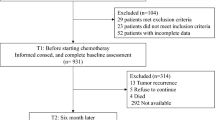Abstract
Use of the Rotterdam Symptom Checklist (RSCL) to measure psychological and physical distress as experienced by cancer patients, is discussed in this paper. The stability of the structure of the RSCL was assessed in principal component analyses in three studies: one concerning cancer patients during either chemotherapy or follow-up (n = 86), one done in patients undergoing chemotherapy for advanced ovarian cancer (n = 56), and the third dealing with cancer patients under treatment, disease-free 'patients', and 'normal' controls (n = 611). The psychological dimension proved to be stable across populations. A scale based on this factor was highly reliable (Cronbach's alpha 0.88-0.94). The physical distress is reflected by several dimensions in a homogeneous population (pain, fatigue, gastrointestinal complaints) and undimensionally in a heterogeneous population. Reliability of the physical distress scales is good (0.71-0.88). The current components of the RSCL and the use of individual and disease specific symptoms are discussed.
Similar content being viewed by others
Author information
Authors and Affiliations
Rights and permissions
About this article
Cite this article
de Haes, J., van Knippenberg, F. & Neijt, J. Measuring psychological and physical distress in cancer patients: structure and application of the Rotterdam Symptom Checklist. Br J Cancer 62, 1034–1038 (1990). https://doi.org/10.1038/bjc.1990.434
Issue Date:
DOI: https://doi.org/10.1038/bjc.1990.434
- Springer Nature Limited
This article is cited by
-
Patientenberichtete Endpunkte in der Kopf-Hals-Tumortherapie: Relevanz, Herausforderungen und Nutzen
HNO (2023)
-
Efficacy and safety of trifluridine/tipiracil (TAS-102) in patients with metastatic colorectal cancer: a systematic review and meta-analysis
Clinical and Translational Oncology (2023)
-
Adaptation of the Patient Benefit Assessment Scale for Hospitalised Older Patients: development, reliability and validity of the P-BAS picture version
BMC Geriatrics (2022)
-
Treatment discontinuation, patient-reported toxicities and quality-of-life by age following trastuzumab emtansine or paclitaxel/trastuzumab (ATEMPT)
npj Breast Cancer (2022)
-
Goal-based outcomes of hospitalisation of older adults are predicted by gender, confidence, quality of life and type of goals
European Geriatric Medicine (2022)




